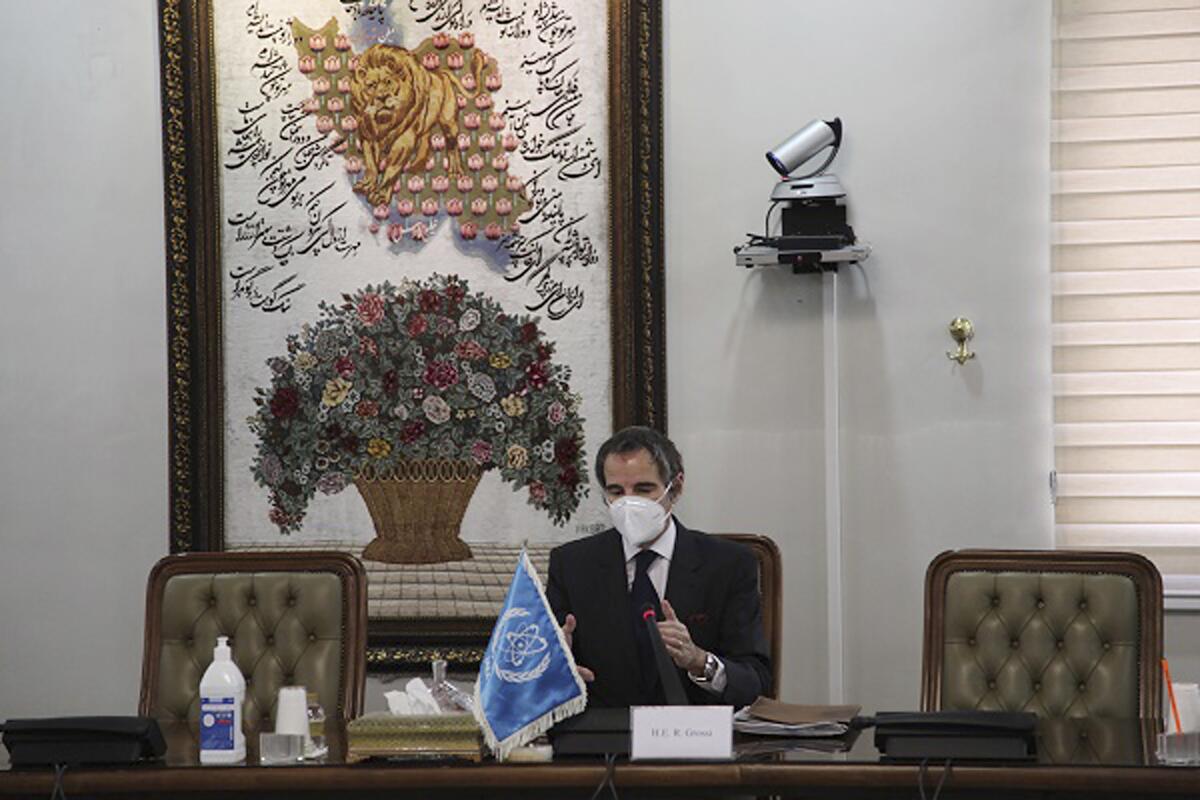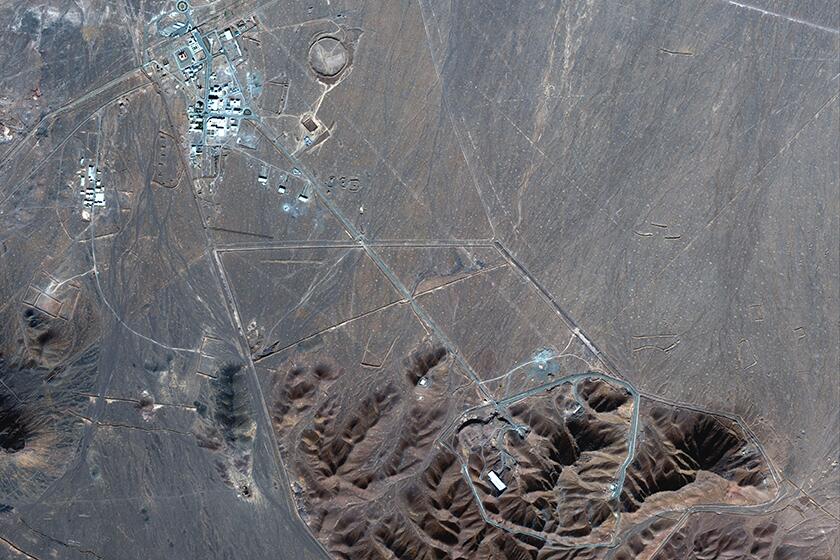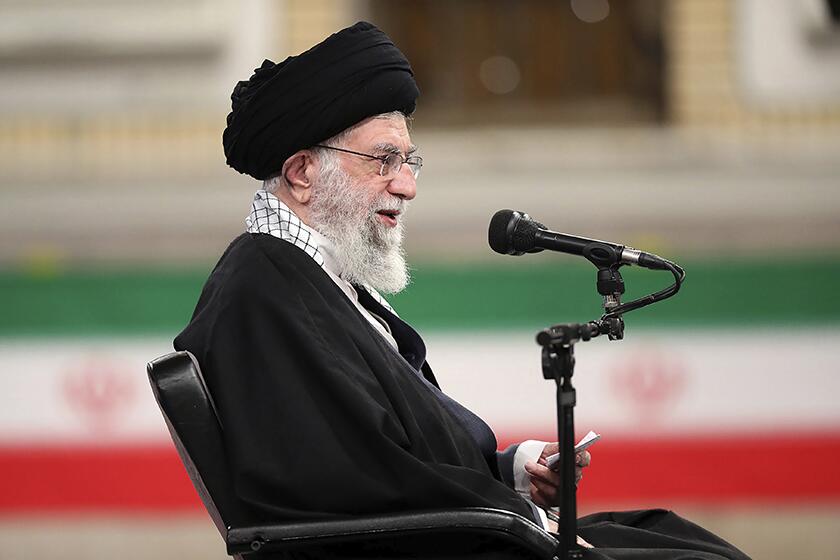U.N. watchdog moves to protect cameras monitoring Iran’s atomic program

- Share via
TEHRAN — The head of the United Nations’ nuclear watchdog met Sunday with Iranian officials in a bid to preserve his inspectors’ ability to monitor Tehran’s atomic program, even as authorities said they planned to cut off surveillance cameras at those sites.
Rafael Grossi’s arrival in Tehran comes as Iran tries to pressure Europe and the Biden administration into returning to the 2015 nuclear deal. Former President Trump unilaterally withdrew America from the deal in 2018.
Iranian Foreign Minister Mohammad Javad Zarif, who under President Hassan Rouhani helped reach the nuclear deal, said the cameras of the International Atomic Energy Agency would be shut off despite Grossi’s visit to follow a law passed by parliament.
“This is not a deadline for the world. This is not an ultimatum,” Zarif told the government-run English-language broadcaster Press TV in an interview aired before he met Grossi. “This is an internal domestic issue between the parliament and the government.
“We have a democracy. We are supposed to implement the laws of the country. And the parliament adopted legislation — whether we like it or not.”
As the Biden administration takes steps toward a renewed detente with Tehran, some of Washington’s Arab allies look on with mounting unease.
Zarif’s comments marked the highest-level acknowledgement yet of what Iran planned to do when it stopped following the so-called additional protocol, a confidential agreement between Tehran and the IAEA reached as part of the nuclear deal. The IAEA has additional protocols with a number of countries it monitors.
Under the protocol with Iran, the IAEA “collects and analyzes hundreds of thousands of images captured daily by its sophisticated surveillance cameras,” the agency said in 2017. The agency also said then that it had placed “2,000 tamper-proof seals on nuclear material and equipment.”
In his interview, Zarif said authorities would be “required by law not to provide the tapes of those cameras.” It wasn’t immediately clear if that also meant the cameras would be turned off entirely as Zarif called that a “technical decision; that’s not a political decision.”
“The IAEA certainly will not get footage from those cameras,” Zarif said.
The Vienna-based IAEA did not respond to a request for comment on Zarif’s statements, though Grossi was expected to address journalists on his return to Vienna late Sunday night. The agency last week said the visit was aimed at finding “a mutually agreeable solution for the IAEA to continue essential verification activities in the country.”
There are 18 nuclear facilities and nine other locations in Iran under IAEA safeguards.
From Washington, U.S. national security advisor Jake Sullivan said President Biden remained willing to negotiate with Iran over a return to the nuclear deal, an offer earlier dismissed by Zarif.
“He is prepared to go to the table to talk to the Iranians about how we get strict constraints back on their nuclear program,” Sullivan told CBS’ “Face the Nation.” “That offer still stands, because we believe diplomacy is the best way to do it.”
The Biden administration took its first step towards returning to the Iran nuclear deal by offering to join talks with Tehran and European sponsors of the agreement.
On U.S. citizens being held by Iran, Sullivan added: “We have begun to communicate with the Iranians on this issue.”
Iranian Foreign Ministry spokesman Saeed Khatibzadeh told state TV late Sunday night, responding to Sullivan, that “there are no direct talks between Iran and the U.S. in any field.” Khatibzadeh said, however, that the Swiss Embassy in Tehran, which has looked out for American interests in the decades since the 1979 hostage crisis, had passed messages between the countries on prisoner issues since Biden took office.
Grossi met earlier Sunday with Ali Akbar Salehi, the head of Iran’s civilian nuclear program. Iran’s ambassador to the IAEA, Kazem Gharibabadi, later tweeted that “Iran and the IAEA held fruitful discussions based on mutual respect, the result of which will be released this evening.”
Iran’s parliament in December approved a bill that would suspend part of U.N. inspections of its nuclear facilities if European signatories did not provide relief from oil and banking sanctions by Tuesday.
Already, Iran has slowly walked away from all the nuclear deal’s limitations on its stockpile of uranium and has begun enriching up to 20%, a technical step away from weapons-grade levels. It also has begun spinning advanced centrifuges barred by the deal, which saw Iran limit its program in exchange for the lifting of economic sanctions.
An escalating series of incidents since Trump’s withdrawal has threatened the wider Mideast. Over a year ago, a U.S. drone strike killed a top Iranian general, spurring Tehran to later launch ballistic missiles that wounded dozens of American troops in Iraq.
A mysterious explosion also struck Iran’s Natanz nuclear facility, which Iran has described as sabotage. In November, Iranian scientist Mohsen Fakhrizadeh, who founded the country’s military nuclear program some two decades earlier, was killed in an attack Tehran blames on Israel.
Zarif brought up the attacks in his interview with state TV, saying the IAEA must keep some of its information confidential for safety reasons.
“Some of them may have security ramifications for Iran, whose peaceful nuclear sites have been attacked,” Zarif said. “For a country whose nuclear scientists have been murdered in terrorist operations in the past — and now recently with Mr. Fakhrizadeh — confidentiality is essential.”
More to Read
Sign up for Essential California
The most important California stories and recommendations in your inbox every morning.
You may occasionally receive promotional content from the Los Angeles Times.












